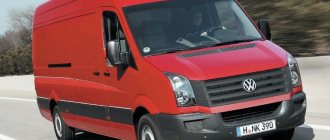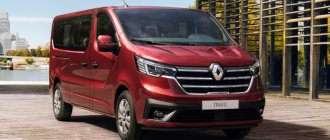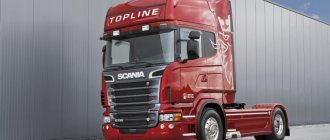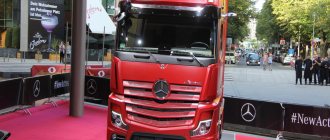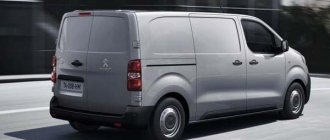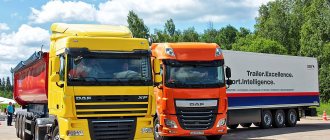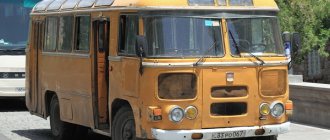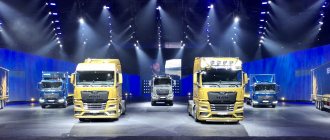Truckers of the 20th century: MAN F90 and MAN F2000. Test Drive
Alexander TROKHACHEV, photo by the author
Two without a lot of electronics
Two, in fact, historical trucks with the lion emblem - F90 and F2000 - were prepared for a test drive along with the TGX highway trucks of the current model range. All the more interesting was the comparison of technology of the 20th and 21st centuries. Two successful series still enjoy the love and respect of carriers in dozens of countries, and Russia is no exception.
Using the example of two German-made truck tractors, one can trace the evolution of technical thought, the development of comfort, efficiency, environmental friendliness and transport efficiency. The merits of these vehicles are recognized by the expert community, and this is confirmed by two Truck of the Year titles: 1987 for the F90 and 1995 for the F2000.
Three generations of German trucks, and each one is at the forefront of technical progress of its time.
A blue MAN 19.402 FL (4×2) F90 series tractor in a special Silent version was prepared for a test drive in the mountains of Catalonia. Its differences from the regular version lie in the comfortable four-point cab suspension and additional sound insulation. The F90 itself replaced the X90 model, received front wheel disc brakes, ABS, a hypoid final drive, and new planetary wheel reduction gears. The car is simple, reliable, as truckers say: “not spoiled by electronics.” At the time of the test in Spain, the total mileage of the 1994 model reached almost 887 thousand km, and it is possible that this is already the second round.
The test MAN 19.464 FL (4×2) F2000 series in black, produced in 2001, has a mileage of over 821 thousand km and, most likely, this is original, that is, the real mileage of the first round. Like its predecessor, there is an old analogue tachograph with a paper washer. By and large, this is a greatly improved version of its predecessor. However, it’s time to touch on the history of two models made in Germany.
MAN F90 : simple as a rake, that’s why it’s good!
The name F90 was given to the new MAN truck range, which debuted in July 1986. It lasted on the production line until the mid-90s and passed the baton to the more modern F2000. When designing the model, the shape of the cabin was kept in the form of a cube - in this form, the driver and his partner are provided with maximum usable space. With the maximum vehicle width allowed at that time being 2.50 m, the new F90 received a width of 2.44 m. For reasons of improving aerodynamic properties, the windshield was tilted at 10 degrees.
Above the windshield of the MAN F90 there are storage boxes and niches..
German engineers sought to make the car durable. That is why all body panels that are exposed to dirt and moisture are made of hot-dip galvanized steel sheet. These are the side parts of the front panel, the outer door trim, and the fastening of the rear wall of the cabin. The black front grille with silver edging, fenders, wheel arches and a solid front bumper are made of plastic.
The wide-opening door and steps make entry and exit into the F90's cabin very easy.
The interior of the F90 cabin was made with an emphasis on comfort and ergonomics. If previously there was a spartan atmosphere, which was compared to a change car, then molded panels visually expanded the space and gave a feeling of comfort. The dashboard without sharp edges has become more ergonomic and more informative. The most important information is displayed on two “saucers” - the round dials of the tachometer and odometer. The driver's work has become easier due to the use of power steering. The glazing of the cabin provides the driver with a good view of the road, and spherical rear-view mirrors are a good addition. The car has also been thought out from a maintenance point of view. The level of comfort in the F90 fully corresponded to the slogan in the advertising brochure: “He who drives calmly, rides well!” Truckers themselves called the car “Bread and Butter,” implying its high performance.
The ergonomics of the MAN F90 driver's seat, after more than three decades, is at a decent level.
All three pedals on the F90 are suspended, at the optimal height and at the right angle.
The F90's upper bunk lifts up just like in a fast train compartment.
The two-spoke steering wheel of the MAN F90 does not overlap the instrument panel in almost any position.
The passenger seat can also be called a place of increased comfort, and without any stretch.
Production of the MAN F90 began in the summer of 1986 with the production of two-axle tractor units and chassis, but the market was much wider. Many sectors of the economy were waiting for a chassis with a corresponding design. The F90 family has been expanded with versions with a narrower cabin, air suspension, all-wheel drive, and a durable steel bumper. In particular, a 2.28 m wide cab was in demand in construction and public utilities. But in terms of the number of orders, the first place remained with 4x2 long-haul tractors with a high roof - this version was shown at the 1989 Frankfurt Motor Show. The roof was raised by 50 cm, and the distance from floor to ceiling reached 2.17 m. The distance between the lower and upper sleeping shelves increased, and the compartments above the windshield became larger. By this time, a power sunroof and seat belts were standard.
In the left slot there is a radio station, without which a truck driver would be without hands. In the center of the ceiling there is an electrically operated tilt-and-slide sunroof.
Behind the F90's standard odometer is an analog recorder for recording the parameters of two drivers.
The F90 series started with the D28 engine, which had three power options: 290, 330 and 360 hp. A year later, the most powerful engine in Europe appeared - a 480-horsepower V10. Based on this power unit, engineers later squeezed out first 500 and then 600 hp. On the one hand, the market demanded more power. On the other hand, engineers in Nuremberg were faced with problems in cleaning exhaust gases. In 1990, all vehicles in Europe had to meet Euro-0 standards, and three years later - Euro-1. If in 1987 460 “horses” were the top, then 10 years later 450-horsepower engines became the norm in long-distance transportation and in the construction sector.
European carelessness: oil sump without any mechanical protection.
Aluminum fuel tank on the right side of the frame.
MAN F90 rear suspension with four air springs. This is still a very popular solution today.
From time to time, MAN used rather rare engineering solutions - for example, 5-cylinder engines with a turbocharger and intercooling of the charge air. Since 1990, they have produced 260 hp, then 270 hp. and even later - 320 hp. The MAN F90 lasted in the series for eight years (1986-1994). During this time, over 100 thousand trucks of this series were manufactured. After which it was the turn of the new generation.
Child of the Millennium: MAN F2000
In 1994, at the IAA international commercial vehicle exhibition in Hannover, the MAN F2000 made its world debut and was awarded the title “Truck of the Year 1995”. It was so similar to its predecessor that some needed a second, closer look at this model. Twin headlights behind a common glass panel made of scratch-resistant plexiglass created a 75% more powerful luminous flux. In this sense, MAN was the first commercial vehicle manufacturer to use such a solution.
The new generation F2000 received frontal lighting technology, combined into a unit under a common glass.
The car received a three-piece bumper, which reduced costs for body repairs. The bumper received an extension of the lower part, which contributed to better engine cooling through the holes and increased passive safety in a collision.
On the MAN F2000 the bumper is not one-piece, but is made up of three parts, with an enlarged lower skirt.
The entrance steps to the F2000 are still open. From the TGA model onwards there will be door extensions.
The light upholstery of the interior visually increases the already rather large interior space.
The driver's door pocket can store two drink containers.
The most significant changes to the F2000 were in the power line. Two years before the legislative introduction of Euro 2 standards, MAN had already created an environmentally friendly engine as far as possible. The first such engines appeared on the F90. They were distinguished by injection injection. The electronics calculated the amount of fuel injected based on a number of parameters. These included: accelerator pedal position, fuel and coolant temperature, injection pressure and much more. The car was equipped with 12- and 16-speed gearboxes. For the first time, the AutoShift automated switching system appeared, which worked with engines with a power of 310-600 hp. Since 2001, Euro-3 standards were introduced by law, and by this time the MAN F2000 Evolution was equipped with engines of this class.
The suspension pedals of the MAN F2000 are arranged in exactly the same way as on the F90.
A soulful approach: the chassis painted red.
The car received four cab options: city, intercity, large sleeper and large sleeper with a high roof. The dashboard was redesigned, the ventilation and heating system, and air conditioning were improved. Seats with fabric and leather upholstery receive lumbar support. Storage compartments were added along the perimeter. There is a wood finish and the ability to accommodate video and TV systems. Ride comfort has been improved by using four-point cab suspension on pneumatic elements instead of coil springs with stabilizers. An electronic air suspension control unit is located to the left of the driver's seat. ECAS (Electronic Shock Absorber Control) monitored the damping setting, making adjustments to compensate for vibration.
The largest cab, the MAN F2000, has a maximum interior height of 2.17 m.
Back in the 20th century, long-haul tractors with a high-roof sleeper cab were at the peak of demand.
In 1998, the MAN F2000 Evolution version appeared, which was distinguished by improved aerodynamics and exterior design. To keep up with high market demand, the F2000 series was produced at plants in Munich and Saotzgitter. The engines came from Nuremberg, the frames and sheet metal from Gustavsburg, and the electrical cables and frame components from Penzberg. In Vienna, the plant carried out special individual orders that could not be fulfilled at the in-line assembly of German enterprises. For example, this concerned a truck tractor for operation in road trains with a gross weight of up to 250 tons, a chassis with a steered rear axle, structures with a number of axles from two to five weighing 50 tons, cargo cranes, snow blowers and other special equipment.
A characteristic feature of the F2000 series trucks: small cells of the decorative radiator grille.
With the introduction of the MAN Trucknology generation in the spring of 2000, the history of the F Series did not immediately end. At first, the MAN TGA and MAN F2000 Evolution were produced on the assembly lines of two factories. With the increasing variety of variants, TGA replaced its predecessor, and in 2002 this also extended to the Vienna plant. After 18 years of production, the F Series story ended there.
The passenger area is also distinguished by a well-thought-out organization of free space.
The ergonomics of the driver's area are made with German scrupulousness.
The instrument panel is simple and at the same time very informative.
By the way, in the spring of 2022, MAN conducted comparative tests of the F90 series (model 19.402 FL Euro-2 1994), F2000 (model 19.464 FL Euro-2 2001) and TGX (model 18.500 BLS EfficientLine 3 Euro-6 2016). The road train with a gross weight of 39 tons traveled the 360-kilometer route three times with different drivers. As a result, the difference in fuel consumption and CO2 emissions was 31.5% in favor of the new vehicle.
Hit the horses and hit the gas!
Despite its respectable age of 33 years, the MAN F90 is still in good shape. Of course, from the cockpit plumage it is noticeable that many of the exterior details are not from 1994, but from a later period. But try to keep the running boards, mudguards, and plastic linings intact during everyday use. In many transport companies, all this falls into the category of consumables. The same can be said about headlight glasses, turn signals, and exterior mirror fairings: rarely does anyone manage to keep them in their original form. And truckers don’t worry about this: at the cargo disassembly site you can find everything you need.
Judging by the stickers where the VIN plate used to be, the cabin has already been repainted. In some places traces of rust are visible along the edges: no matter what you say, nothing lasts forever. Overall the car is well maintained, but it also has problems. For example, the radio wires are not hidden under the skin, and stains are visible on the ceiling in the center of the roof - the hatch is leaking. But everything else is in good condition.
The engine starts without problems. Of course: it’s plus twenty degrees Celsius outside, and the car is being watched. There really is a lot of space in the cabin. The driving position is comfortable and visibility is just right. Hidden behind the speedometer, which folds towards the driver, is an analog tachograph with a paper “puck”, designed to record the trip parameters of two drivers. Original solution!
The ZF mechanical “16-mortar” with range and divider is very good. In addition to the fact that it allows you to choose the lower and upper row of gear ratios, it has “halves”. In the mountains, this allows you to change gears less frequently, using the divider key if necessary. As a person spoiled by the technologies of the 21st century, I note: you often have to switch gears on the old F90 not only when starting to move, at junctions, ascents and exits, but also on the highway. Whatever you say, the modern TipMatic gearboxes on the MAN TGX are a real blessing!
The later and technically more advanced MAN F2000, and even in the Silent version, has the same 16-speed manual transmission. But the driving experience with a modern semi-trailer is different. In particular, the cabin is less noisy (thanks to the additional sound insulation). Nothing rattles or creaks. The level of lateral roll and longitudinal vibrations is probably comparable. But the difference is 60 hp. noticeable. If the 400-horsepower F90 at a speed of 60 km/h already loses acceleration dynamics, then the 460-horsepower F2000 retains it even after 70 km/h. The directional stability of both cars is good, but still the F90 looks more “tired”. But both tractors brake excellently and handle excellently: curved radii pass as if on rails.
The potential of the 6-cylinder engine is 460 hp. even for the Catalan mountains it is enough.
As a result, despite their advanced age, both “Germans” are ready to fly even now. The only question is how efficient the transportation will be. After all, you need to keep in mind: older trucks need more frequent maintenance and replacement of parts, which increases the cost of ownership. It is not for nothing that Europeans view them more as historical exhibits than as vehicles for generating income from the delivery of goods. As they say, everything has its time.
Long-distance-mangruzovik.ru. Instructions for repairing special equipment.
All electrical diagram sheets are high resolution, click on the electrical diagram to view full size.
Electrical diagram MAN launch control, power supply of power circuits, pressure indicators in air tanks (receivers), fuel level indicator, oil pressure indicator, diagram of indicator lamps, fuel level indicator, fuel sensor, pneumatic cabin lock switch, glow plug relay, starter switch .
,
Electrical diagram MAN tachograph, tachometer, power take-off circuit, differential lock, neutral position, pneumatic switch for driven axle and reference axle.
Electrical diagram of MAN sound signals, brake lights, reversing lights, heated rear-view mirrors, turns and hazard lights, standard cabin stove (heater), cigarette lighter, interior lighting, step lighting, sleeping bag lighting.
Electrical diagram of MAN windshield wiper, headlight cleaner, instrument lighting, high and low beams, parking lights, side lights, fog lights, engine braking system, 12\24 volt converter,
Headlight washer circuit and engine braking circuit,
Purpose of fuses, switching the engine braking button, connecting the engine braking time relay, engine speed limit sensor, air dryer heater, engine stop solenoid valve, headlight washer motors (left and right).
electrical starting circuit and system - hot start. Description of connections for starter, alternator, glow plugs, glow plug relay, timing valve, accessory relays, fuses and plug connections.
Electrical diagram for MAN control of power windows and heated rear view mirrors
Description of connecting the left and right power window relays, electric motors for raising/lowering the side windows, connecting the rear view mirror defroster, connecting the ground, plug connections with the designation of each wire.
electrical diagram of emergency lights and turn signals. Description of the switching of the junction box, fuses, relays, connection of all turning lamps and repeaters, connection of the control lamp on the instrument panel,
Electrical diagram of parking lights, license plate lights, headlights, reverse gear, dimensions. Description of connection and switching of the junction box, connection of the headlight relay, reversing lights, low beam and high beam headlight relays, connection of the switch on the steering column, fuses, plug connections with a description of the numbering of wires and contacts.
Wiring diagram of the windshield wiper, windshield washer circuit, instrument panel illumination circuit and cabin light switch.
Universal switchgear, pinout and internal switching.
Fuses and relays located in the mounting block.
Description of components, purpose on MAN electrical circuits.
MAN F90 wiring diagram EDC MS-5 (engine management)
MAN F2000 wiring diagram EDC MS-5 (engine management)
